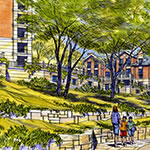Southwest Properties has a unique opportunity: to create an entire neighborhood from scratch on a 65-acre, undeveloped parcel within a densely populated urban area. The site, located about a half mile from the peninsula that encompasses the oldest part of Halifax, Nova Scotia, had been owned by the Sisters of Charity religious order since 1872. The land is mostly open space with stands of mature trees along the perimeter. It is the rarest of beasts: a large, greenfield property close to an urban core.
The design for the Motherhouse project, as it is known, emphasizes respect for the natural landscape. Many mature trees will be preserved. Attributes of new urbanism—such as walkability, mixed-use structures, parks, and connection to mass transit—inspire the layout. Halifax-based Southwest, a developer and apartment management company, intends to apply for LEED-ND certification for the entire development. The mixed-use towers, townhouses, and single-family homes within the Motherhouse boundaries also will be constructed with an eye toward LEED certification. When fully built out, the project is expected to house between 4,000 and 5,000 residents.


The new urbanist design concept fosters sustainability by reducing the need for car travel. The development’s core will be a densely packed retail “town center” anchored by mixed-use towers, not typical suburban strip malls. “We can significantly mitigate traffic by making it a self-sustaining place,” says Jim Spatz, Southwest’s chairman and CEO. Necessities and amenities such as medical services, grocery stores, cafés, restaurants, and various consumer services will be located no more than a seven-minute walk from any address in the development.
The tree-preservation effort began with a tree inventory of the entire site. “This led us to shift parts of our street plan so that we could save more trees,” Spatz says. Streets will be narrower than normal for new development, and most parking will be either below-grade or off-street, in order to foster a more pedestrian-friendly environment. Streets will be bordered by bike paths and sidewalks.


Public parks are interspersed throughout the design, one located around an existing pond and another formed around a man-made water-retention basin. The goal of the landscape features is to retain as much rainfall runoff on-site as possible.
Significantly, the development may include a central plant featuring a cogeneration or tri-generation heating, cooling, and power system. Southwest is discussing joint development of such a system with neighboring Mount Saint Vincent University.
Although the Motherhouse project is notable for its scope and sustainable elements, the design is in step with Southwest’s core philosophy. “We have always invested in lifecycle values in our properties,” Spatz says. In recent times, the public’s environmental awareness has increased, and Southwest has responded with more energy-efficient projects. “There’s a large appetite to live sustainably,” Spatz says. “Sustainability sells.”

